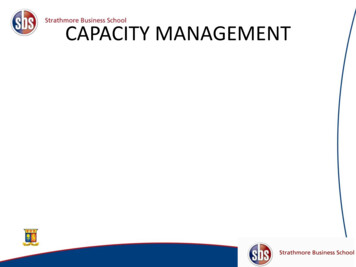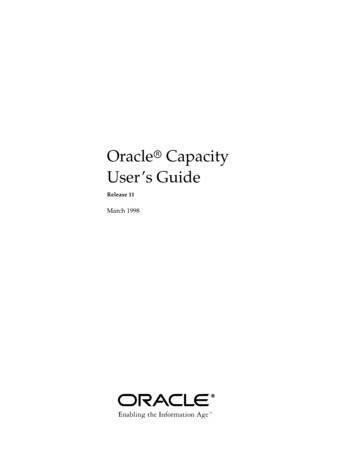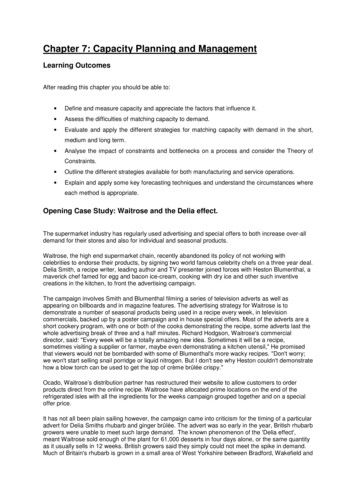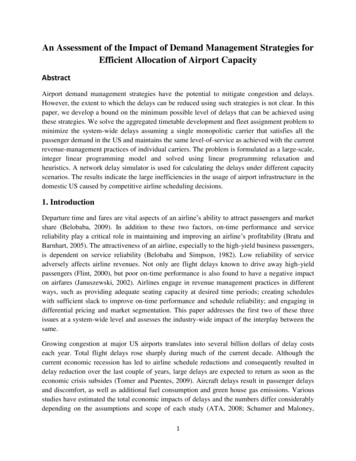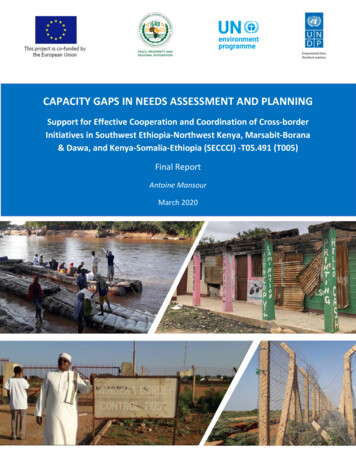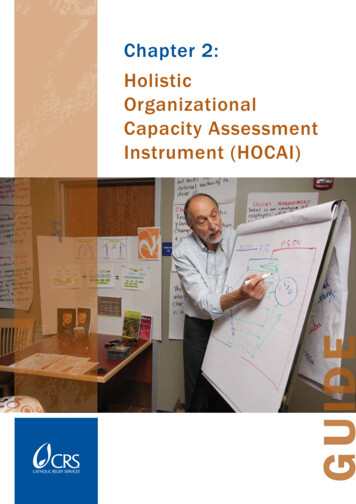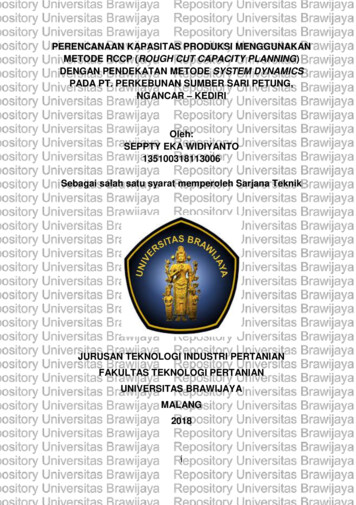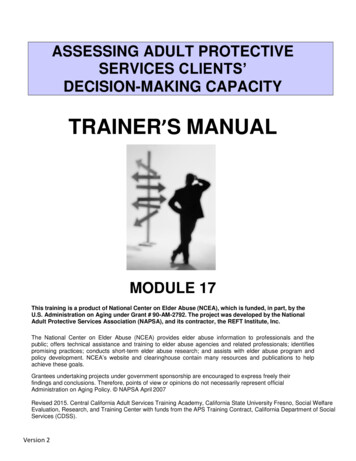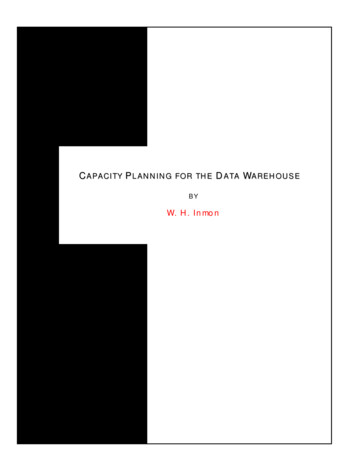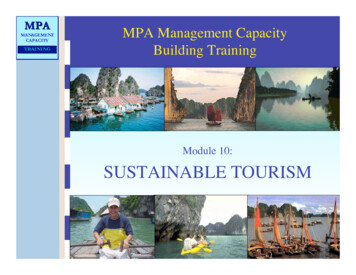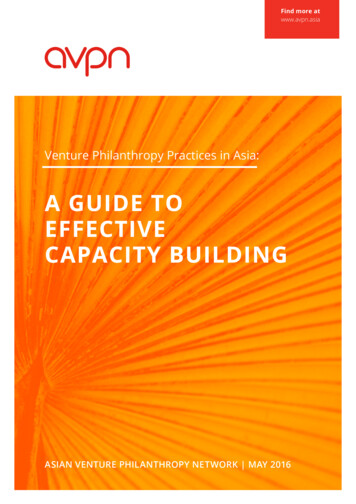
Transcription
Find more atwww.avpn.asiaVenture Philanthropy Practices in Asia:A GUIDE TOEFFECTIVECAPACITY BUILDINGASIAN VENTURE PHILANTHROPY NETWORK MAY 2016
AVPN Venture Philanthropy Practices in AsiaPublished by the Asian Venture Philanthropy Network in May 2016About AVPNThe Asian Venture Philanthropy Network (AVPN) is a membership network headquarteredin Singapore that seeks to increase the flow of financial, human and intellectual capital tothe social sector, and to improve the social impact effectiveness of members across theAsia Pacific region. We promote venture philanthropy in the broader philanthropic and socialinvestment communities and provide specific networking and learning services to meet theneeds of our members.We have over 280 organisations from 28 different countries spanning different sectors. We arebuilding a cross-sector network bringing together organisations and individuals from finance,business and the social sector. Our members include private equity firms, private banks, wealthmanagement institutions, other financial services organisations, professional service firms,family businesses, corporations, foundations, universities and government-related entities.Copyright aAuthor:Design:Martina Mettgenberg-Lemiere, PhDGabriela Karch, HeidelbergThis work is licensed under the Attribution-NonCommercial-ShareAlike 4.0 International License:Attribution — You must give appropriate credit, provide alink to the license, and indicate if changes were made.NonCommercial — You may not use the material forcommercial purposes.ShareAlike — If you remix, transform, or build upon thematerial, you must distribute your contributions underthe same license as the original.AVPN is grateful to acknowledge the support of2 www.avpn.asia
Find more atwww.avpn.asiaVenture Philanthropy Practices in Asia:A GUIDE TOEFFECTIVECAPACITY BUILDINGMARTINA METTGENBERG-LEMIERE, PHD MAY 2016
AcknowledgementsThis guide would have not been possible without the generous sharing of practices of thefollowing individuals in these organisations:Mavis MengBritish CouncilWonyoung KimCrevisseYoshitaka TabuchiJapan Venture Philanthropy Fund (JVPF)Patsian LowDBS FoundationNaveen JhaDeshpande Foundation IndiaPeter YangEmpactKensuke Sasaki, Mitsuhiko Yamazakiand Yuko MotokiETIC.Julia GrantImpetus-PEFNanako KudoJapan Venture Philanthropy FundKaren NgSocial Ventures Hong KongVijaya BalajiToolbox IndiaIn terms of co-authoring cases, we acknowledge the help of the following conference andsummer associates from April to December 2015:Mila DevenportRaman SidhuBethany TangAlex WongJing ZhangIn addition to this, we are grateful for help on numerous aspects of this report to the entireAVPN Team and in particular: Stacey Choe, Patti Chu, Ken Ito, Caroline McLaughlin, AnyaSubberwal, Naina Subberwal Batra, Kevin Teo and Clive YeLast but not least, we are grateful for many inspiring discussions with:Paul CarttarBridgespan GroupLisa HehenbergerEVPA, ESADEPriscilla BoiardiEVPA4 www.avpn.asia
Definitionsin this guideSocial Purpose Organisation (SPO)AVPN considers an organisation to be a Social Purpose Organisation if it possessesthese characteristics:1. Primary objective of delivering social impact2. Interacts directly with beneficiaries3. Receives funds as part of delivering on primary objectiveThis includes but is not limited to non-profit organisations (NPOs), non-governmentalorganisations (NGOs), charities and social enterprises (SEs).Venture Philanthropy Organisation (VPO)AVPN considers an organisation to be a Venture Philanthropy Organisation if it possessesthese characteristics:1. Provides SPOs with a combination of financial and non-financial support to deliversocial impact2. Focused on multi-year, milestone-based support programmesThis includes but is not limited to foundations, trusts, giving circles, CSR departments andimpact investing funds. A VPO may use grant making (donations) or social investment (equity,debt, etc) approaches to funding SPOs, together with non-financial support.CapabilityUsed by Impetus-PEF and describes the ability of an organisation to deliver. It answers thequestion of “What can an organisation do?”.CapacityCapacity is the collective sum of all capabilities, e.g. we are building the capabilities ofthis organisation in order to increase the capacity of the organisation. “How much can anorganisation do?”Capacity BuildingSimilar to non-financial support (NFS), capacity building strengthens the skills and abilities ofan organisation.
ContentsSection 10509Definitions in this guideIntroductionSection 2101213151516171820Capacity building in practice from design to impact2.1 Understandingyour motivation incapacity building2.2 Gauging the SPO’s needsSection 42632384247546167732.3 DeliveringCapacity Building77§§ Standard services82§§ Determining your abilityto deliver§§ Delivering capacity building- efforts and costsBritish Council China, ChinaCrevisse, South KoreaDBS Foundation, SingaporeDeshpande Foundation India,IndiaEmpact, SingaporeETIC., JapanImpetus- PEF, UKJapan Venture PhilanthropyFund (JVPF), JapanSocial Ventures Hong Kong(SVhk), Hong KongToolbox India, IndiaSection 52.4 Impact Assessment2.5 In summaryCapacity Building in Practice Case studies from Asia87Recommended ReadingSection 323How to use the CapacityBuilding Canvas24Capacity Building Canvaswww.avpn.asia 7
Capacity Building in PracticeINTRODUCTION
A Guide to Effective Capacity BuildingIn the emerging social investing landscape of Asia, socialinvestors support social purpose organisations in manydifferent financial and non-financial ways. Providingboth well is critical for social purpose organisations to becomeinvestment- and impact-ready.The Effective Guide on Capacity Building combines an overview of best practices in socialinvesting and venture philanthropy as well as highlights ten case studies focused on Asia tocreate a practical one-stop guide.In the first section, we zoom in on what needs to be considered in order to design and deliveryour capacity building programme. In particular, we consider how to understand your ownmotivation to build capacity and how you can gauge your investees’ needs. Following the initialfundamental assessment, we guide you through ways of delivering capacity building and focuson what kind of services are seen as most useful, assessing your ability to deliver them as wellas structuring the delivery of your capacity building in terms of efforts and costs. In the finalsection we outline three approaches to assessing the impact of your capacity building.This section is followed by the Capacity Building Canvas, which helps you to understandstrengths and weaknesses in each of the areas within capacity building and allows you to focuson the most suitable solutions for your organisation.Finally, we introduce ten case studies in Asia to help you learn from actual examples ofdifferent funders’ practices. We will focus in particular on the delivery structure and also outlinechallenges overcome, achievements made and impact assessment wherever available.If you have any comments or want to get involved in future reports, please contact us atknowledge@avpn.asia.www.avpn.asia 9
Capacity Building in PracticeFROM DESIGNTO IMPACT
A Guide to Effective Capacity BuildingIn venture capital and private equity, capital has been described asa commodity – with the real differentiation being the non-financialsupport that is extended by the investor to the investee. This iseven more applicable in venture philanthropy where funding fuelssolutions to social issues. Non-financial support or capacity-buildingby the investor is the crucial addition to allow investees to developbetter solutions to the problems they aim to solve, while becomingsustainable and/or profitable.AVPN defines capacity building as any input, advice or support, which the VPO provides orenables, that is intended to enhance the ability of the SPO to increase its impact. Each VPOhas different motivations, approaches and methods, which will determine what best servesthe SPO’s objectives and means. There are many ways to build capacity and this guide aimsto deliver a clear understanding of what capacity building is and help you develop your ownmethodology for implementation.Whatever method is implemented, the ultimate goal of capacity building is increased socialimpact. To reach this critical outcome, we see a three-part solution:1. Develop a clear understanding of the overall situation and the SPOs’ needs2. Structure your capacity building delivery3. Measure the difference that capacity building has made and the resulting on-FinancialSupportSocial PurposeOrganisation(SPOs)ActionIncreasedSocial ImpactFigure 1 – Theory of change for Capacity Building, AVPN content, 2015www.avpn.asia 11
AVPN Venture Philanthropy Practices in Asia2.1 Understanding your Motivation in Capacity BuildingMost of the studied organisations would foster alignment between their investee/grantee/SPO and themselves during the due diligence process prior to investment. Most investorswould check back regularly during the investment period to ensure that investees have bothunderstood the mission and vision and contributed towards these goals. The first step toeffective capacity building is a clear understanding of the needs of both your organisationand the SPO.There were many different motivations in the cases from the AVPN community across Asia.In addition, literature on capacity building illustrated differing investors’ aims in buildingorganisations as well as supporting market growth.The most pertinent reason was that several funders see capacity building as a key way tosupport the organisation non-financially in their quest to produce both investment- and impactready organisations. Investment readiness refers to the ability of the SPO to be sustainable ifnot profitable. Impact readiness refers to the ability to reliably and predictably deliver socialoutcomes/services.However, what investment- or impact-readiness looks like may differ. Impetus-PEF1distinguished the following business models in SPOs: the donation-based model, where thedonations fuel the sustainability of the enterprise while the social mission is fulfilled for andwith different stakeholders; the side-by-side model, wherein the SPO gives back in connectionwith its own growth and finally, the embedded model, where social mission is grown as thebusiness side is grown.Aside from the business model, another factor is the stage of the SPO: start-up, early-stage,growth or later stage. Which capabilities need to be built for which business model at whichstage are outlined in Impetus-PEF’s table.2 It details the growth stages of the enterprise and theorganisational type (embedded, side-by-side, donation model) on the horizontal x-axis and thecapabilities to be built on the y-axis. These include revenue model, social programme design,leadership and team, financial capacity and risk management, performance management andevidence of impact. At the intersection of two parameters, some key performance indicators(KPIs) are listed. For instance, for embedded business models seeking what needs to beachieved in social programme design (y-axis) in the start-up phase (x-axis) the table suggeststhat “Social Mission (social change one aims to achieve) may be loosely defined, but can beclearly articulated by leader” (intersection); in the early stage, this suggestions transformsinto “Operational blueprint being defined specifying: social mission, target population,long-term outcomes, short and intermediate outcomes, programme design, performancemanagement processes”.By thinking about the capacities along business model and development stage, investors canbe more targeted in developing impact– and investment-readiness. This simultaneously buildsthe “market” for social impact where investors can have more confidence in investing in certainsocial outcomes through SPOs.Although related to investment readiness but not necessarily critical to building the market,a VPO’s motivation may also be to increase performance of the organisation similar to the12AVPN case study on Impetus-PEF available at y-foundation/Impetus-PEF, 2014, pp. 16-1712 www.avpn.asia
A Guide to Effective Capacity Buildingfor-profit world (more for equity if you expect a financial return, e.g. Crevisse3; for increasedsocial return, e.g. Inspiring Scotland, Toolbox Foundation4). The performance mind-set is takenfrom the venture capital industry, wherein organisations are built in order to become strongerin their return and revenue functions. This is evident in the support that VPOs give to theirinvestees/grantees.For instance, Inspiring Scotland (IS)5 performance advisors are appreciated for their privatesector business acumen/expertise. They are mostly senior professionals from finance, law,accountancy, and public/third sectors. Similarly, Toolbox Foundation draws on corporatepro-bono SBV to address lack of management skills in SPOs. Others, such as JapanVenture Philanthropy Fund, support organisations with a revenue model and then applybusiness acumen or support grant-dependent companies with fundraising strategy andgovernment support.6Finally, many established VPOs lend credibility to their SPO partners who then leverage thefunder’s reputation to secure further funding and resources. Shell Foundation’s establishedname and reputation gave credibility to their partner SPOs who built on Shell’s brand tosecure further funding/pro-bono partnerships.7 Similarly, IS portfolio organisations felt thatestablished image of Inspiring Scotland helped open doors for them when they sought newfunding/services.8 EdelGive also explicitly advocates for their organisations by recommendingtheir organisations to other funders.9 Building the capacity of their organisation increasesthe “branding” and recognition value of their SPO and then builds confidence in the socialinvestment eco-system.A few questions to ask in this area:1. What is the purpose of the SPO in requesting Capacity Building?2. What is your purpose in delivering Capacity Building?3. What is the most effective intervention to date from the SPOs perspective? What arethe VPO’s views?4. What is the developmental stage of the organisations and itscorresponding needs?102.2 Gauging the SPO’s NeedsClarifying your motivation forms the foundation for your capacity building and should beused to inform the other moving parts of your strategy. From this motivation, you can aim tounderstand the way you interact with the SPO. We have observed several ways to interact.During the due diligence phase, the VPOs and SPOs decide on the strategy for capacity buildingas well as the milestones associated with capacity building. The next step then usually involvesbiannual or quarterly reviews with the organisation. Depending on the kind of organisation,3456789AVPN case study on Crevisse, available at visse/AVPN case study on Toolbox India, available at lbox-india/Isserman, 2013Gugelev and Stern, 2015, available at http://ssir.org/articles/entry/whats your endgameShell Foundation, 2010, p. VIsserman, 2013, p. 5AVPN case study on EdelGive Foundation, available at cy-and-funders-network/10 Impetus-PEF, 2014, pp. 16-17www.avpn.asia 13
AVPN Venture Philanthropy Practices in Asiataking a board seat is a common way of keeping in touch, while more informal funders preferslack11 seats or messaging platforms to foster the cohesion and allow for frequent, transparentinteractions. These modes of interaction are needed to increase the ability of the SPO to deliverimpact. However, it is worth considering how many of these touch points are pressure points. Ifthis creates pressure rather than mutual learning and challenge, the relationship between VPOand SPO can be skewed towards the funder. In the short term this may not allow the SPO toshare their needs, which in the longer term could determine the success of the SPO.This is critical because a funder’s interaction with their SPO will influence how the interventionis perceived and whether the learnings become embedded in the organisation. It is vital thatoutcomes are set as achievable targets that both SPOs and VPOs have agreed upon together.From our case studies, some organisations are prescriptive in assessing needs based on theirbenchmarks. In the case of Impetus-PEF this is based on a deep understanding of what isneeded at each level. Other VPOs work with the SPOs to understand what they need and codevelop a customised strategy based on their needs.In 2015, AVPN was part of the Expert Group on Non-Financial Support at the European VenturePhilanthropy Association (EVPA). The group and EVPA further defined how to assess needs inthe three areas of:§§ Impact strategy§§ Financial sustainability§§ Organisational resilienceIn each of these areas there are four levels that organisations can and should achieve.12A few things to ask yourself to determine the needs of your investees:1. What are your interaction points with the SPO? Are they touch- or pressure points?2. What are the SPO’s needs? How can addressing one particular need multiply/knock-on/amplify other needs (e.g. fundraising and communication)?3. Will this support be used? How relevant is the support to the organisation, rather thanthe funder?4. In what intervals are results achievable and visible?5. Who decides what an acceptable output looks like?11 Slack is a cloud-based team collaboration tool, which provides messaging, project management and integration with otherplatforms such as GoogleDrive, Dropbox and GitHub.12 Tool 4 (under Step 2) can be accessed here: ntre/non-financial-support-process-tools/.14 www.avpn.asia
A Guide to Effective Capacity Building2.3 Delivering Capacity BuildingNow that you have roughly understood your motivation and the SPO’s needs, we introduce howyou can structure the delivery of your capacity building. To that end, we review the standardservices being offered, how you can determine what you provide and finally how you structurethe delivery of the support.Standard servicesServices can be split into structured and customised support.Structured support are courses with specific topics to help organisations develop a clearlydefined skill set or capacity. IT courses or impact assessment workshops are a structuredservice. An advantage is that the VPO can provide training to a group of SPOs at the same time.Also, at the early stages of development, the needs of the SPO may be significant and manyoperational activities need to be streamlined and changes addressed. Two drawbacks are that itis not customised to either the individual needs or the strategy of the SPO.Customised services, on the other hand, are adapted to the SPO’s needs and strategy. Thesetend to include coaching and consulting in all areas of impact and business. Customisedservices may be more effective13, but are generally costlier, as each SPO requires adifferent approach. In our sample of case studies from Asia, the majority of VPOs offercustomised services.In general, services delivered by VPOs include:141. Board development and governance assistance2. Staff and management training3. Information technology assistance4. Communications/marketing/publicity assistance5. Use of facilities6. Seminars/forums/conventions7. General management & strategic planning advice8. Financial planning/accounting9. Development of performance measures10. Facilitated collaborations11. Networking and introductions to leaders or peers in or beyond the field12. Insights on field, research or best practices13 There is little overarching evidence on effectiveness at this stage, although attempts to measure have been made, see WINGS 4Csframework used by DAFNE for instance: http://dafne-online.eu/difference/14 CEP, 2008, p. 8www.avpn.asia 15
AVPN Venture Philanthropy Practices in AsiaFrom this salad bar, VPOs tend to choose what is feasible within their budget and skillsavailability. EVPA found in its 2014 Annual Survey15 that the top-ranking services are:§§ Strategy consulting§§ Coaching, mentoring of the CEO or the management team§§ Access to networks§§ Financial planning§§ Management§§ Fundraising or revenue strategyIt is worth keeping in mind that these are not definite lists for success, but insights that seemto work depending on the VPO or SPO, at a particular time (2008 and 2013) and place (US andEurope). In that light, let us look at how you can enable non-financial support in your context.Determining your ability to deliverTo determine what services to offer, most organisations in our case study sample started withthe SPOs in mind and fulfilled their needs accordingly and as best as possible. The Centrefor Effective Philanthropy16 found in the US context in 2008 that VPOs tend to decide what toprovide based on:§§ Grantee requests for specific assistance§§ Confidence in grantee’s ability to make the most of the assistance provided§§ Perception of what would be most beneficial to the grantee§§ Importance of grantee to achieving programmatic objectives/goals.However, doing this may mean that you exceed your own budget and hence becomeineffective in helping future or other SPOs. Against this backdrop, the EVPA expert group onnon-financial services recently developed three tools to assess need and monetisation of yourcapacity building17:§§ Mapping capacity building to your theory of change to understand what areas arecore to your strategy – Step 1, Tool 1§§ An asset-mapping tool allowing you to assess the needs for human resources –Step 1, Tool 2§§ A capacity building monetisation tool helping you to estimate the costs ofCapacity Building – Step 1, Tool 3Together or alone, these three tools may give you an idea of what is critical as well as how muchstaff and finances are needed.15 EVPA Annual Survey, 2014, p. 5, available at survey/16 Centre for Effective Philanthropy, 2008, p. 717 EVPA Non-Financial Support Process Tools available for download at entre/non-financial-support-process-tools/16 www.avpn.asia
A Guide to Effective Capacity BuildingStructuring the delivery of capacity building in terms of effortand costsFrom our case studies, we found that there are commonly three layers to deliver thecapacity building programme: the programme design, the programme management andthe programme implementation. At all times, the decision for customised or structuredprogrammes lies with the VPO and often with the portfolio manager. Within these layers thereare three different constellations with rising complexity.One is for the programme to be designed, managed and implemented by the portfoliomanager of the VPO. This is constellation 1. Most of the time, we found that it would be theportfolio manager who manages the service delivery through paid professionals, subsidisedstaff, pro-bono or skills-based volunteers, volunteers or peers, which indicates a two-layeredservice delivery and is indicated here as constellation 2. Finally, the portfolio manager can workwith an intermediary to deliver the service through volunteers, paid consultants or low-bonostaff, in which case all three layers exist – see constellation 3.18Paid professionals,Subsidised staff (low-bono)Pro-bono/skills-based AGEMENTPROGRAMMEDESIGNPortfolioManager,in-house IntermediaryPortfolioManager1 2 PortfolioManager3Customised/structured programmeFigure 2 – Constellations for programme delivery, AVPN analysis, 2015These distinctions are important because they impact the roles of different stakeholders (VPO,Service Manager and Service Delivery) and mean that the effort to deliver capacity building isdistributed in different ways.Similar to effort, costs are also distributed in numerous ways. In our case studies, we found thateffort allocation had implications for who is paying for capacity building. If the VPO engagespaid professionals, the question is whether the VPO or SPO pays for the service. If the SPOpays, the VPO can help by pre-screening and pre-negotiating prices with the service providerbefore the SPO engages. This is the common practice at Crevisse.19 Sometimes, the VPO also1819AVPN case study on Toolbox India available at lbox-india/AVPN case study on Crevisse available at visse/www.avpn.asia 17
AVPN Venture Philanthropy Practices in Asianegotiates pro-bono services to SPOs as is the case of JVPF.20 Most of the time, the VPO assistswith managing the relationship between service providers in the shape of skills-based/pro-bonovolunteers and hence covers effort as well as helps reduce costs for the SPO.This may appear vague but by outlining these options we invite you to think through differentconstellations and help you find the one that works best for you. Similarly, as you progressand measure the impact of different constellations, you will be able to make firmer datadriven decisions.2.4 Impact AssessmentThe three questions to keep in mind for the impact assessment in capacity building are:1. What do you really want to know about CB?2. How do your investees measure and assess their effectiveness?3. How do other VPOs approach this challenge?As mentioned before, the foundation of your actions in capacity building should always be theSPO and their goal to make a difference. As a funder you are supporting them to achieve thisimpact — rather than, for example, placing your employees for employeeengagement ngNon-FinancialSupportSocial PurposeOrganisation(SPOs)ActionIncreasedSocial ImpactSPO’s Theory of Change / KPIsContext for assessing overallperformance capacity buildingFigure 3 – SPO theory of change for CB impact assessment, AVPN content, 2015In terms of ‘what you really need to know’, there are a number of different possibilities. Oneis to understand how your SPO leverages their capabilities to generate social impact. Anotheris to understand how efficient the approach is. Similarly, you could also ask how they areprogressing towards an aim that they have identified as a requirement for success. Then youcan also measure if your contribution is effective and how you make a difference to the SPO’s20AVPN case study on JVPF available at an-venture-philanthropy-fund/18 www.avpn.asia
A Guide to Effective Capacity Buildingdevelopment. Related to this, you could also question how the capacity building delivered hasbeen valued by the SPO.Measuring the impact of capacity building functions in the same way as how impact assessmentworks.21 To that end it is worthwhile deciding what the parameters for the impact assessmentare. Is the VPO also measuring the impact on the beneficiaries or only the impact on the SPO?Most organisations we have been speaking with therefore develop a logic model of theircapacity building with the SPO based on the framework by W.K. Kellogg Foundation22:12345Certain resourcesare needed tooperate yourprogrammeIf you have accessto them, then youcan use them toaccomplish yourplanned activitiesIf you accomplishyour plannedactivities, then youwill hopefullydeliver the amountof product and/orservice that youintendedIf you accomplishyour plannedactivities, to theextent youintended, then yourparticipants willbenefit in certainwaysIf these benefits toparticipants areachieved, thencertain changes inorganisations,communities, orthe systems mightbe expected iesPlanned WorkIntended ResultsFigure 4 – Example of Logic Model, W.K. Kellogg FoundationWhen designing the logic model and deciding on the indicators, each indicator should bemeasurable by a tool or some form of inquiry. You could measure the indicator through routinediscussions, management reporting, routine data collection, internal/external surveys, externalanalysis and formal evaluation.To narrow down the approaches to the various ways of measuring the impact of capacitybuilding, we observed three approaches.Approach 1: assess SPO impact to gauge capacity building effectivenessThis considers which capability of the SPO is most critical to driving the desired impact. Due tothe wide range of support they provide to SPOs, VPOs often utilise multiple approaches at keypoints throughout the engagement. Approach 1 tends to utilise the full range of informationcollecting, data analysis techniques and formal evaluation in the form of RandomizedControl Trials (RCTs).This is probably one of two most common approaches. SVhk, for instance, considers theSPO’s impact as an outcome of the entire support – financial and non-financial – provided.SVhk requires quarterly reports to be sent to its management team and board from all ofits organisations.21 See the AVPN Impact Assessment Guide, 201622 W K Kellogg Foundation, 2006, Logic Model Development Guide, available at nt-guidewww.avpn.asia 19
AVPN Venture Philanthropy Practices in AsiaApproach 2: assess the effectiveness of specific capacity building approaches oractivities in actually enhancing the SPO’s critical capacitiesIn this approach the organisation measures one particular intervention such as a volunteerprogramme or other specific project, while c
Capacity is the collective sum of all capabilities, e.g. we are building the capabilities of this organisation in order to increase the capacity of the organisation. "How much can an organisation do?" Capacity Building Similar to non-financial support (NFS), capacity building strengthens the skills and abilities of an organisation.
